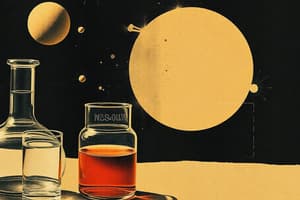Podcast
Questions and Answers
What is a defining characteristic of a suspension?
What is a defining characteristic of a suspension?
- It appears clear and uniform.
- It is formed by a solid dissolving in a liquid.
- Light can pass through it easily.
- It consists of particles that settle upon standing. (correct)
Which of the following is an example of a colloid?
Which of the following is an example of a colloid?
- Salt water
- Mud
- Vinegar
- Ketchup (correct)
How do homogeneous mixtures differ from heterogeneous mixtures?
How do homogeneous mixtures differ from heterogeneous mixtures?
- Homogeneous mixtures can be seen through while heterogeneous cannot.
- Homogeneous mixtures always consist of liquids, while heterogeneous consist of solids.
- Homogeneous mixtures settle upon standing, but heterogeneous do not.
- Homogeneous mixtures have uniform composition while heterogeneous do not. (correct)
What is an alloy?
What is an alloy?
Why are some liquid medicines advised to be shaken before use?
Why are some liquid medicines advised to be shaken before use?
Which of these substances is considered a solution?
Which of these substances is considered a solution?
In which type of mixture can you typically identify the individual components?
In which type of mixture can you typically identify the individual components?
What happens to a solution when it is left to stand?
What happens to a solution when it is left to stand?
Which characteristic distinguishes a suspension from other mixtures?
Which characteristic distinguishes a suspension from other mixtures?
How does a solution differ from a colloid in terms of component visibility?
How does a solution differ from a colloid in terms of component visibility?
Which mixture can be formed by combining a solid with a liquid without settling?
Which mixture can be formed by combining a solid with a liquid without settling?
What type of mixture is characterized by being uniform throughout?
What type of mixture is characterized by being uniform throughout?
In what context might a doctor recommend shaking a liquid medicine?
In what context might a doctor recommend shaking a liquid medicine?
Which example is not a homogeneous mixture?
Which example is not a homogeneous mixture?
What term describes a mixture with a metal as the main component?
What term describes a mixture with a metal as the main component?
Which of these mixtures is classified as a heterogeneous mixture?
Which of these mixtures is classified as a heterogeneous mixture?
Flashcards are hidden until you start studying
Study Notes
Mixtures
- A suspension is a heterogeneous mixture where some substances do not completely dissolve in the solvent.
- Suspensions will settle upon standing and light cannot pass through them.
- Examples of suspensions include muddy water, certain salad dressings, and flour in water.
Types of Mixtures
- Homogeneous mixtures: Components are uniformly mixed and appear the same throughout.
- Heterogeneous mixtures: Components are not uniformly mixed, and different parts of the mixture look different.
- Solutions: Homogeneous mixtures that are usually clear, do not settle, and allow light to pass through.
- Colloids: Homogeneous mixtures that are usually cloudy, do not settle, and partially allow light to pass through.
- Suspensions: Heterogeneous mixtures that settle upon standing and block light.
Solutions, Colloids, and Suspensions
- Solutions: A solute dissolves in a solvent, resulting in a homogeneous mixture.
- Examples of solutions include saltwater, sugar water, coffee, and air.
- Colloids: Homogeneous mixtures where particles are dispersed but do not settle.
- Examples of colloids include milk, paint, and smoke.
- Suspensions: Heterogeneous mixtures where particles settle over time.
Homogeneous and Heterogeneous Mixtures
- Homogeneous mixtures: Components are completely mixed and uniform throughout. Examples include brewed coffee, body cream, milk, air, vinegar, saltwater, and steel.
- Heterogeneous mixtures: Components are not uniform and can be identified. Examples include fruit salads, pizzas, chocolate chip cookies, oil and water mixtures, and sausage buns.
Let's Know More!
- Alloys: Mixtures where a metal is the main component. Example: Steel is an alloy of iron and carbon.
Mixtures of Different Forms
- Mixtures can exist in solid, liquid, or gas forms.
- Examples: Mixed nuts (solid), mixed fruit juices (liquid), air (gas).
Suspensions
- A suspension is a heterogeneous mixture where some substances do not dissolve completely in the solvent.
- The mixture will settle upon standing.
- Light cannot pass through suspensions.
- Examples include muddy water, some types of salad dressing, and flour in water.
Types of Mixtures
- Mixtures can be categorized as homogeneous, heterogeneous, solutions, colloids, and suspensions.
Solutions, Colloids, and Suspensions
- A solution is a homogeneous mixture that is typically clear and does not settle.
- The substance that dissolves is called the solute, and the substance it dissolves in is called the solvent.
- Examples of solutions include coffee, orange juice, vinegar, salt water, sugar water, tea, air, and alcohol.
- A colloid is also a homogeneous mixture that does not settle but is usually cloudy. It allows a partial beam of light to pass through it.
- Examples of colloids include smoke, paints, ketchup, milk, starch solution, ointments, and creams.
Homogeneous and Heterogeneous Mixtures
- Homogeneous mixtures have components that are completely mixed and uniform throughout. We cannot distinguish the individual components.
- Examples of homogeneous mixtures include brewed coffee, body cream or lotion, milk, air, vinegar, salt water, and steel.
- In heterogeneous mixtures, the components are not uniform and can be identified.
- Examples of heterogeneous mixtures are fruit salads, pizzas, chocolate chip cookies, mixtures of oil and water, and sausage buns.
Alloys
- An alloy is a mixture where a metal is the primary component.
- Steel is an example of an alloy, a mixture of iron and carbon.
Mixtures of Different Forms
- Mixtures can exist in solid, liquid, or gaseous forms.
- Examples include mixed nuts (solids), mixed fruit juices (liquids), and air (gases).
Studying That Suits You
Use AI to generate personalized quizzes and flashcards to suit your learning preferences.




